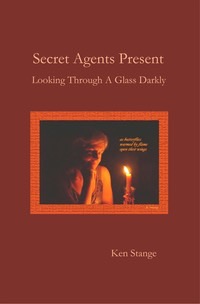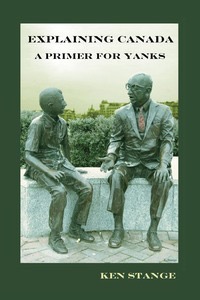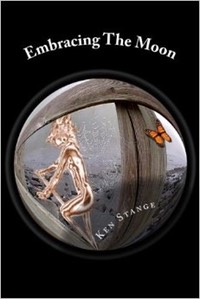Secret Agents Past: The Parting Of The Waters
(2014)

Secret Agents Past is the first in a trilogy on the similarities and the differences in creativity in the arts and in the sciences. While informal in tone and sprinkled with personal anecdotes, it is an in-depth examination of the topic. It specifically looks at the cultural divide between the arts and the sciences that C. P. Snow called “The Two Cultures”. By closely examining the similarities and differences in the nature of creativity in these two domains, it resolves the false division of art and science. To accomplish this, the author draws on philosophy and psychology as well as personal experience in both domains.
Available from
- Amazon.com (where you can look inside)
- Amazon.ca (for Canadian buyers)
- Two Cultures Press.com (where signed editions are available)
- Also available at discriminating independent bookstores
- Including Gulliver's Books (Toll Free at 1-888-BAY-BOOK)
Secret Agents Present: Looking Through A Glass Darkly
(2014)

Secret Agents Present is the second in a trilogy on the similarities and the differences in creativity in the arts and in the sciences. As with the previous volume the tone is casual but the scholarship sound. This book focuses on the current status of creativity in the arts and sciences. It presents what psychology now knows about the relationship of mental illness, morality, memory, and motivation to creative accomplishment. It also considers the effects of new creative tools on the evolving definition of ‘creativity’.
Available from
- Amazon.com (where you can look inside)
- Amazon.ca (for Canadian buyers)
- Two Cultures Press.com (where signed editions are available)
- Also available at discriminating independent bookstores
- Including Gulliver's Books (Toll Free at 1-888-BAY-BOOK)
Secret Agents Future: Going Where There Be Dragons
(2014)

Secret Agents Future is the final book on similarities and differences in creativity in the arts and the sciences is more speculative, for it attempts to extrapolate future developments in creative endeavor. The exponential growth in technology equips artists with new tools, and thus inevitably introduces them to the value of science in their own creative domain. Also considered are probable new forms of collaboration between artists and scientists. Its generally optimistic predictions are based on recent trends that suggest the pointless rift between science and art is finally being bridged.
Available from
- Amazon.com (where you can look inside)
- Amazon.ca (for Canadian buyers)
- Two Cultures Press.com (where signed editions are available)
- Also available at discriminating independent bookstores
- Including Gulliver's Books (Toll Free at 1-888-BAY-BOOK)
Explaining Canada: A Primer For Yanks
(2014)

Explaining Canada is a humorous and satirical contemporary guide to Canada intended for both American and Canadian readership. It deals with the cultural differences between Canada and America, including the arts, politics, ethnicity, and attitudes. Of course nobody can really explain Canada. Americans might find some of the remarks about their country’s idiosyncrasies annoying, just as Canadians might object to the description of Canada’s quirks.
The author justifies his perspective on the basis of having spent the first several decades of his life in The States and the remaining decades north of the border. His insights into the notable differences between these countries are only possible for an immigrant.
Available from
- Amazon.com (where you can look inside)
- Amazon.ca (for Canadian buyers)
- Two Cultures Press.com (where signed editions are available)
- Also available at discriminating independent bookstores
- Including Gulliver's Books (Toll Free at 1-888-BAY-BOOK)
Going Home: Cycling Through The Heart Of America
(2014)

Going Home is the record of a three-week cycling trip undertaken by a middle-aged man and his son, pedaling 2,500 kilometers from New Orleans back up the map to their home in Canada. For the father it was a brief return to the country that was his home for the first two decades of his life. For his son, it was an introduction to the country that had shaped his father. This book is about this land seen more intimately than is possible in a car.
It is also about the people they met along the way: 'Saint' Cecil of Natalbany, Louisiana; Ma and the homebody farmer at Ma's Hitching Post in rural Tennessee; Dennis 'The Hustler' in Nashville; Rose and Albert at The Jam Factory in Louisville; the 'Third Brother' in Bowling Green; Jimmy of The Crow Bar in Sabina; Billy 'The Biker' on the Geneva Strip; and many others, all people that somehow within minutes (or hours) came to personify and capture, like apt images in a poem, the heart of America.
Available from
- Amazon.com (where you can look inside)
- Amazon.ca (for Canadian buyers)
- Two Cultures Press.com (where signed editions are available)
- Also available at discriminating independent bookstores
- Including Gulliver's Books (Toll Free at 1-888-BAY-BOOK)
Embracing The Moon: Twenty-Five Little Worlds
(2013)

The great poet Li Po drowned after trying to embrace the moon reflected in the still waters of an isolated lake. These 25 concise and sensuous poems, each paired with a stunning and provocative colour digital artwork, also embrace that incarnation of the tantalizing mystery of our existence in this immense universe that the moon universally symbolizes. The images are startling and the poems cut to the quick of our emotional vulnerability as strangers in a strange land. It is not just a book for readers of poetry or visual art enthusiasts. It for anyone who has looked at the moon and wondered what it all means.
Introducing the works is an interesting historical discussion of the tanka, the pithy verse form used by Li Po and used for all of these poems, as well as an explanation of the inspiration and genesis of the book. Also included are endnotes on all of the works, which possibly may further the reader’s appreciation by placing them in a larger context.
Available from
- Amazon.com (where you can look inside).
- Amazon.ca (for Canadian buyers)
- Two Cultures Press.com (where signed editions are available)
- Also available at discriminating independent bookstores
- Including Gulliver's Books (Toll Free at 1-888-BAY-BOOK )
God When He’s Drunk
(2012)

Tom Waits penned and sang the immortal lines referenced in the title: “Don’t you know there ain’t no devil, there’s just God when he’s drunk.” He had it right. How else explain the bizarre twists of fate that shape our lives, so well captured in this collection of eighteen stories? As diverse in style as they are in theme, they all share a deep sense of irony about the human condition.
The settings range from a neuroscience lab (in the tale of “The Heart Of A Rat”, which won the prestigious 2011 Vanderbilt-Exile Prize for short fiction) through earthquake-shattered San Francisco to a bar on Bourbon Street. And the harsh realism of stories about discovering the sordid details of a friend’s demise or the life of a stripper contrast with poignant and fantastic tales of actually meeting God hiding in a southern town, designing and creating one’s ideal mate, and trading in one’s body for a newer model. God may have been drunk, but he had a sense of humour—albeit a very dark one.
Available from
- Amazon.com (where you can look inside)
- Amazon.ca (for Canadian buyers)
- Two Cultures Press.com (where signed editions are available)
- Also at discrminating independent bookstores
- Including Gulliver's Books (Toll Free at 1-888-BAY-BOOK)